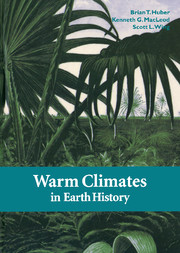Book contents
- Frontmatter
- Contents
- List of contributors
- Preface
- Part 1 Approaches to the study of paleoclimates
- 1 Warm climate forcing mechanisms
- 2 Recent advances in paleoclimate modeling: toward better simulations of warm paleoclimates
- 3 Comparison of zonal temperature profiles for past warm time periods
- Part II Case studies: latest Paleocene–early Eocene
- Part III Case studies: Mesozoic
- Part IV Case studies: Paleozoic
- Part V Overview: climate across tectonic timescales
- Index
- Plate section
3 - Comparison of zonal temperature profiles for past warm time periods
from Part 1 - Approaches to the study of paleoclimates
Published online by Cambridge University Press: 06 July 2010
- Frontmatter
- Contents
- List of contributors
- Preface
- Part 1 Approaches to the study of paleoclimates
- 1 Warm climate forcing mechanisms
- 2 Recent advances in paleoclimate modeling: toward better simulations of warm paleoclimates
- 3 Comparison of zonal temperature profiles for past warm time periods
- Part II Case studies: latest Paleocene–early Eocene
- Part III Case studies: Mesozoic
- Part IV Case studies: Paleozoic
- Part V Overview: climate across tectonic timescales
- Index
- Plate section
Summary
ABSTRACT
A standard explanation for past warm time periods involves higher atmospheric CO2 levels. However, model simulations indicate that the zonal temperature response to a CO2 perturbation is significantly different from observations in the geologic record: model-predicted temperatures are higher in low latitudes and lower in high latitudes than revealed by observations. Although changes in ocean heat transport have been invoked to account for such discrepancies, it is also necessary to subject zonal temperature profiles, particularly tropical sea surface temperature (SST) estimates, to error analysis in order to test for robustness of conclusions. Herein we conduct such an analysis and demonstrate that it is difficult to generalize about the tropical SST pattern in low latitudes during warm periods. Three time periods (Pliocene, Eocene, Cenomanian) indicate tropical SSTs not significantly different from the present, while two time periods (Miocene and Maastrichtian) suggest cooler tropical SSTs. Diagenesis may be responsible for some of the cooler tropical temperature estimates. Analysis of uncertainties in δ O-based paleotemperature estimates suggests that random non-dissolution-related uncertainties are in the order of 2–3 °C for individual specimens. However, averaging of Holocene core top samples yields zonal mean temperature estimates in the tropics that agree with observations to within 0.5–1.0 °C. Although there is a potential for pre-Pleistocene uncertainties of 2–4 °C in tropical SSTs (due to diagenesis and salinity/alkalinity changes from CO2 variations), careful screening of samples should produce a smaller non-random uncertainty of +1.5 to –3.0 °C for the zonal average from multiple sites.
- Type
- Chapter
- Information
- Warm Climates in Earth History , pp. 50 - 76Publisher: Cambridge University PressPrint publication year: 1999
- 7
- Cited by



